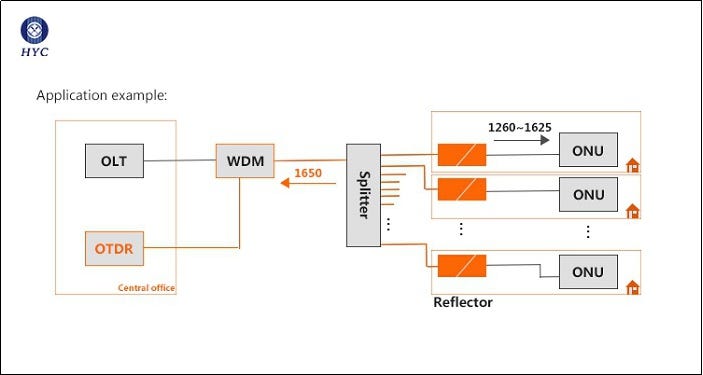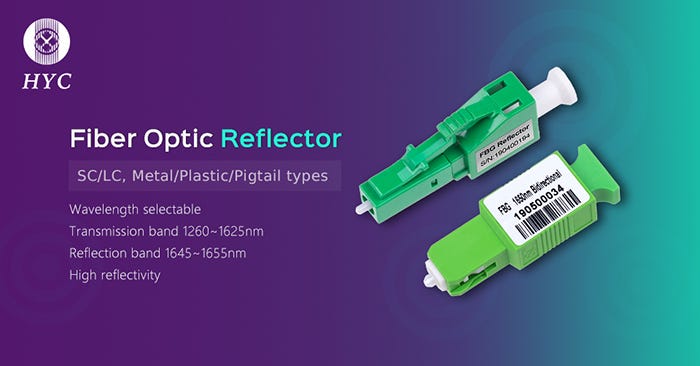- Posts: 36
- Thank you received: 2
×
Questions regarding all aspects of Fiber Optics manufacturing and production go here.
How to Use Fiber Optic Reflector for PON Monitoring?
- Mrs Bella Tse
- Topic Author
- Offline
- Junior Boarder
-

Less
More
5 years 6 months ago #3040
by Mrs Bella Tse
How to Use Fiber Optic Reflector for PON Monitoring? was created by Mrs Bella Tse
In the PON (Passive Optical Network) network, especially the complex point-to-multipoint PON ODN (Optical Distribution Network) topology applications, rapid monitoring, and diagnosis of fiber fault locations is a challenging subject. At present, optical time-domain reflectometer (OTDR) tools are widely used for monitoring the fiber network. However, OTDR detection may not be so particularly sensitive to the attenuation of optical signals at the ends of some ODN branch fibers or ONU fibers. The application of FTTx terminal splitter to the main cable signal makes the traditional OTDR fiber optical detection techniques unable to achieve on-off detection. So a cost-effective and wavelength selective fiber optic reflector is a basic method of implementation of optical layer monitoring on the whole length of an FTTx network from the OLT to the ONT in real-time.
The working principle of the fiber optic reflector is mainly to use Fiber Bragg Grating (FBG) to reflect the test light pulse sent by OTDR with nearly 100% reflectivity. But the wavelength of normal passive optical network (PON) will pass with a small attenuation. The main purpose is to accurately calculate the return loss value of the reflected event at the end of each ONU branch by detecting whether the reflected OTDR test signal exists and the intensity of the optical signal. Therefore, it can easy to determine whether the optical link from the OLT side to the ONU side is normal. By detecting the reflected signal through OTDR, it can accurately grasp the fiber breakage, loss anomalies, fault location, and locate the error quickly.
By deploying fiber optic reflectors at the different positions to monitoring different ODN sections, the fiber faults position can be quickly identified. The fault processing time can be reduced, and the test efficiency and fiber line maintenance quality can be improved.
In the first-level splitting scene, the fiber optic reflector installed on the ONU side. If the reflected return loss of a certain fiber branch is significantly increased compared with the return loss value of the health file, it indicates that there is a problem with the fiber link of this branch. If all the fiber branches with fiber optic reflectors have obvious return loss at the same time, it indicates that the trunk fiber has a fault.
In the second-level splitting scene, the difference of return loss can be compared to accurately locate whether the distribution fiber segment or the indoor fiber segment has attenuation fault. In both the first and second spectral scenes, there will be a steep drop of the reflection peak at the end of the OTDR test curve, so the return loss value of the longest branch link in the ODN may not be accurately measured. It is necessary to measure the variation of the reflector's reflection level to serve as the basis for fault measurement and diagnosis.
Optical fiber reflectors can also be installed where deployment is required. For example, FBG can be installed before the distribution optical fiber enters the home (FTTH)/ building (FTTB), cooperating with OTDR to determine the fault of indoor/outdoor, in-building/out-building optical fiber. The reflector is considered the best way of implementing real-time end to end(OLT to ONT) monitoring of optical layer in live FTTx networks.
The www.hyc-system.com fiber optic reflector is easy to install in the user's home, so as to determine the location of the optical path fault through different reflections of the test signal. With wide bandwidth and low insertion loss, the FBG reflectors are ideal components to monitor live network utilizing OTDR at the termination of passive optical network without disturbing traffic. HYC provides FBG fiber optic reflectors of various package types, plastic housing, metal housing, and Pigtail type form SC or LC connector, etc.
The working principle of the fiber optic reflector is mainly to use Fiber Bragg Grating (FBG) to reflect the test light pulse sent by OTDR with nearly 100% reflectivity. But the wavelength of normal passive optical network (PON) will pass with a small attenuation. The main purpose is to accurately calculate the return loss value of the reflected event at the end of each ONU branch by detecting whether the reflected OTDR test signal exists and the intensity of the optical signal. Therefore, it can easy to determine whether the optical link from the OLT side to the ONU side is normal. By detecting the reflected signal through OTDR, it can accurately grasp the fiber breakage, loss anomalies, fault location, and locate the error quickly.
By deploying fiber optic reflectors at the different positions to monitoring different ODN sections, the fiber faults position can be quickly identified. The fault processing time can be reduced, and the test efficiency and fiber line maintenance quality can be improved.
In the first-level splitting scene, the fiber optic reflector installed on the ONU side. If the reflected return loss of a certain fiber branch is significantly increased compared with the return loss value of the health file, it indicates that there is a problem with the fiber link of this branch. If all the fiber branches with fiber optic reflectors have obvious return loss at the same time, it indicates that the trunk fiber has a fault.
In the second-level splitting scene, the difference of return loss can be compared to accurately locate whether the distribution fiber segment or the indoor fiber segment has attenuation fault. In both the first and second spectral scenes, there will be a steep drop of the reflection peak at the end of the OTDR test curve, so the return loss value of the longest branch link in the ODN may not be accurately measured. It is necessary to measure the variation of the reflector's reflection level to serve as the basis for fault measurement and diagnosis.
Optical fiber reflectors can also be installed where deployment is required. For example, FBG can be installed before the distribution optical fiber enters the home (FTTH)/ building (FTTB), cooperating with OTDR to determine the fault of indoor/outdoor, in-building/out-building optical fiber. The reflector is considered the best way of implementing real-time end to end(OLT to ONT) monitoring of optical layer in live FTTx networks.
The www.hyc-system.com fiber optic reflector is easy to install in the user's home, so as to determine the location of the optical path fault through different reflections of the test signal. With wide bandwidth and low insertion loss, the FBG reflectors are ideal components to monitor live network utilizing OTDR at the termination of passive optical network without disturbing traffic. HYC provides FBG fiber optic reflectors of various package types, plastic housing, metal housing, and Pigtail type form SC or LC connector, etc.
Please Log in to join the conversation.
Moderators: Erik A Macs, Peter J Stewart-Hay
Time to create page: 0.058 seconds





 How to resolve AdBlock issue?
How to resolve AdBlock issue? 

